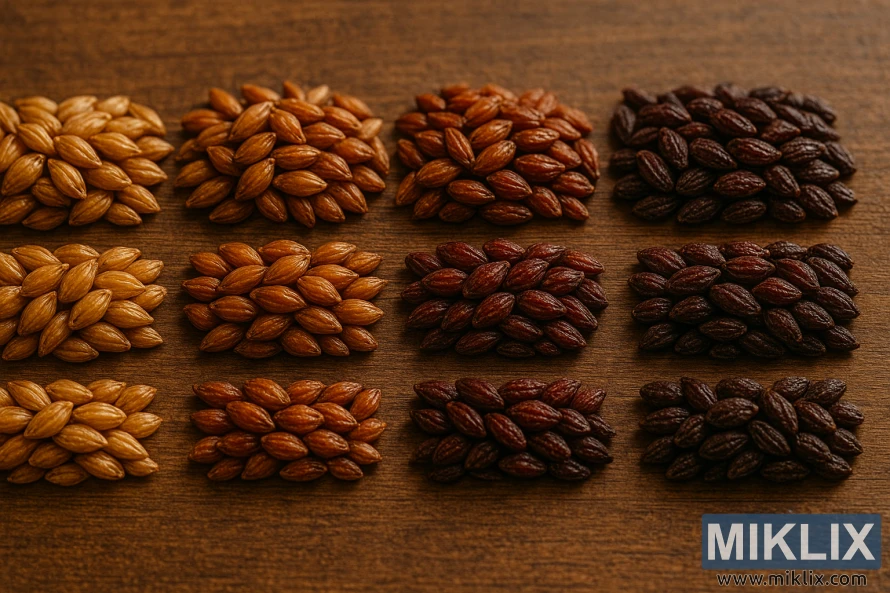Image: Variety of crystal malts
Published: August 12, 2025 at 6:26:45 AM UTC
Last updated: September 27, 2025 at 4:01:34 PM UTC
Crystal malts in shades from amber to ruby arranged on wood, showcasing artisanal detail and the care in selecting malts for brewing recipes.
Laid out with meticulous precision on a warm, wooden surface, the image presents a stunning visual spectrum of crystal malts, each pile representing a distinct roast level and flavor potential. Organized in a grid of four rows and five columns, the arrangement is both aesthetically pleasing and functionally informative, offering a clear and deliberate comparison of malt varieties used in brewing. The lighting is soft and natural, casting gentle highlights across the glossy surfaces of the grains and enhancing their rich, earthy tones. From the top left to the bottom right, the colors transition gradually—from pale golden hues to deep, almost black shades—mirroring the progression of caramelization and Maillard reactions that occur during the roasting process.
The lighter malts in the upper left quadrant shimmer with amber and honey tones, their kernels plump and smooth, suggesting a mild roast that preserves much of the original sweetness and enzymatic activity. These malts are typically used to add body and a subtle caramel note to lighter beer styles, such as golden ales or mild bitters. As the eye moves diagonally across the grid, the colors deepen and the textures become more pronounced. Mid-range crystal malts, with their copper and burnt orange hues, offer a more complex flavor profile—notes of toffee, toasted bread, and dried fruit begin to emerge. These malts are often favored in amber ales, ESBs, and bocks, where a richer malt backbone is desired.
Toward the bottom right, the darkest malts command attention with their intense ruby, mahogany, and near-black coloration. Their surfaces are slightly more irregular, with some kernels appearing cracked or deeply ridged, a visual cue to their robust roast level. These malts contribute bold flavors—dark chocolate, espresso, and hints of burnt sugar—ideal for porters, stouts, and other full-bodied, malt-forward beers. The progression of color and texture across the grid not only illustrates the diversity of crystal malts but also underscores the brewer’s palette, where each variety serves a specific purpose in shaping the final product’s taste, aroma, and appearance.
The wooden surface beneath the grains adds warmth and authenticity to the composition, its subtle grain and natural imperfections reinforcing the artisanal nature of the brewing craft. The soft lighting enhances this mood, creating a sense of intimacy and focus, as if the viewer has stepped into a quiet moment of recipe development or ingredient selection. There’s a tactile quality to the image—one can almost feel the weight of the grains, smell their sweet, roasted aroma, and imagine the transformation they’ll undergo in the mash tun.
This image is more than a catalog of malt types—it’s a visual narrative of brewing intention. It speaks to the care and expertise required to select the right combination of malts for a specific beer style, balancing sweetness, color, and complexity. It invites the viewer to appreciate the subtle differences between each variety, to understand how roast level influences flavor, and to recognize the craftsmanship behind every pint. In this neatly arranged grid of crystal malts, the essence of brewing is distilled into a single, harmonious tableau—where tradition, science, and sensory experience converge.
The image is related to: Brewing Beer with Caramel and Crystal Malts

